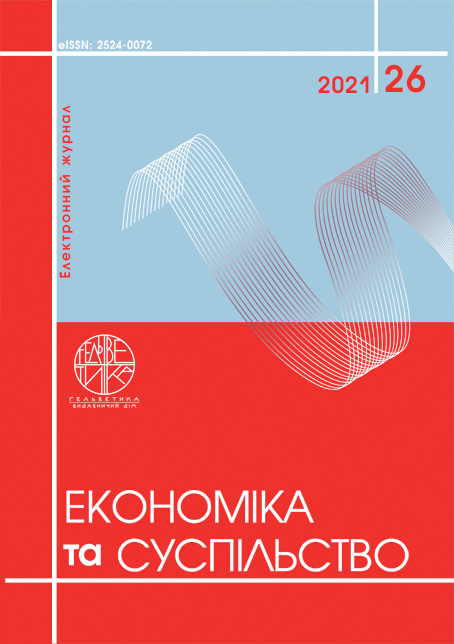КЛАСТЕРИЗАЦІЯ КРАЇН ЦСЄ ЗА ПОКАЗНИКАМИ ЗЕД
Анотація
Стаття присвячена проблемам розвитку зовнішньоторговельної діяльності країн Центральної та Східної Європи, особливостям їх соціально-економічного розвитку, а також проблемам трансформації економічних систем. У статті розглянуто питання кластеризації країн за показниками зовнішньоекономічної діяльності, а саме індексом чистої торгівлі, експортною квотою ( показником відкритості економіки), імпортною квотою, надходженням прямих іноземних інвестицій у відсотках до валового внутрішнього продукту; витіканням прямих іноземних інвестицій у відсотках до валового внутрішнього продукту; портфельними інвестиціями. Також висвітлено проблеми диференціації між країнами Центральної та Східної Європи, здійснено статистичний аналіз обраних країн за показниками: імпортна та експортна квоти, а також здійснено візуалізацію цих даних.
Посилання
Dziubanovska N. Multifactor models for studying the EU countries’ international trade. Економічний часопис-ХХІ. 2019. № 175(1-2). С. 29–34.
Gussenov B., Bastaubaev A. Model of development of foreign economic activity in the conditions of integration processes and globalization. N ews of the national Academy of sciences of the Republic of Kazakhstan. Series of social and human sciences. 2019. № 5(327). С. 134–139.
Vahalík B., Staníčková M. Key factors of foreign trade competitiveness: Comparison of the EU and BRICS by factor and cluster analysis. Society and Economy. 2016. № 38(3). С. 295–317.
Staníčková M., Vahalík B., Fojtíková L. Globalization, International Trade and Competitiveness: What Links These Concepts? Challenge or Threat for Competitiveness of the World Economic Players–Especially EU, US and China?. European Integration. 2018. С. 1361.
Benešová I., Smutka L., Laputková A. Specifics of the Mutual Trade of the Post-Soviet Countries. Entrepreneurial Business and Economics Review. 2019. №7(1). С. 29–43.
Benešová I., Smutka L., Rumánková L., Laputková A., Novotná Z. Regional Cooperation of the Post Soviet Countries–Can it Be Influenced by the Structure of the Economy?. Acta Universitatis Agriculturae et Silviculturae Mendelianae Brunensis. 2016. №64(6). С. 1843–1856.
Forte R., Santos N. A cluster analysis of FDI in Latin America. Latin american journal of economics. 2015. № 52(1). С. 25–56.
Silva V., Forte R. The Impact of Foreign Direct Investment on Home Country Exports. Journal of International Commerce, Economics and Policy. 2018. №9, С. 1850005.
Danaci T., Nacar R. Comparing the Foreign Trade and Logistic Performance of Turkey and EU Members with Cluster Analysis. PressAcademia Procedia. 2017. № 3(1). С. 31–36.
Dai T. Characteristics of International Trade Benefits Based on the Cluster Analysis of Compatibility Relation. International conference on Big Data Analytics for Cyber-Physical-Systems Springer, Singapore. 2019. С. 1060–1067.
Egger P. H., Tarlea F. Multi-way clustering estimation of standard errors in gravity models. Economics Letters. 2015. №134. С. 144–147.
Baltagi B. H., Egger P. H., Pfaffermayr, M. Panel data gravity models of international trade. CESifo Working Paper. 2014. №4616. 59 с.
Зовнішньоекономічна діяльність. Державна служба статистики України : веб-сайт. URL: http://www.ukrstat.gov.ua (дата звернення: 24.10.2020).
Dziubanovska, N. (2019). Multifactor models for studying the EU countries’ international trade. Економічний часопис-ХХІ, 175(1-2), 29–34.
Gussenov, B., & Bastaubaev, A. (2019). Model of development of foreign economic activity in the conditions of integration processes and globalization. N ews of the national Academy of sciences of the Republic of Kazakhstan. Series of social and human sciences, 5(327), 134–139.
Vahalík, B., & Staníčková, M. (2016). Key factors of foreign trade competitiveness: Comparison of the EU and BRICS by factor and cluster analysis. Society and Economy, 38(3), 295–317.
Staníčková, M., Vahalík, B., & Fojtíková, L. (2018). Globalization, International Trade and Competitiveness: What Links These Concepts? Challenge or Threat for Competitiveness of the World Economic Players–Especially EU, US and China? on European Integration 2018, 1361.
Benešová, I., Smutka, L., & Laputková, A. (2019). Specifics of the Mutual Trade of the Post-Soviet Countries. Entrepreneurial Business and Economics Review, 7(1), 29–43.
Benešová, I., Smutka, L., Rumánková, L., Laputková, A., & Novotná, Z. (2016). Regional Cooperation of the Post Soviet Countries–Can it Be Influenced by the Structure of the Economy?. Acta Universitatis Agriculturae et Silviculturae Mendelianae Brunensis, 64(6), 1843–1856.
Forte, R., & Santos, N. (2015). A cluster analysis of FDI in Latin America. Latin american journal of economics, 52(1), 25–56.
Silva, V., & Forte, R. (2018). The Impact of Foreign Direct Investment on Home Country Exports. Journal of International Commerce, Economics and Policy, 9(01n02), 1850005.
Danaci, T., & Nacar, R. (2017). Comparing the Foreign Trade and Logistic Performance of Turkey and EU Members with Cluster Analysis. PressAcademia Procedia, 3(1), 31–36.
Dai, T. (2019, December). Characteristics of International Trade Benefits Based on the Cluster Analysis of Compatibility Relation. In International conference on Big Data Analytics for Cyber-Physical-Systems (pp. 1060-1067). Springer, Singapore.
Egger, P. H., & Tarlea, F. (2015). Multi-way clustering estimation of standard errors in gravity models. Economics Letters, 134, 144–147.
Baltagi, B. H., Egger, P. H., & Pfaffermayr, M. (2014). Panel data gravity models of international trade. CESifo Working Paper, №4616. 59.
State Statistic Service of Ukraine (2020). Foreign economic activity : website. URL: http://www.ukrstat.gov.ua (accessed 24 October 2020).


